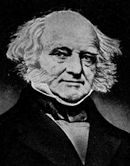
Return to U.S. Presidency - Index Page.
Return to U.S. Presidents' Biographies Page.
Born: 12/5/1782
Birthplace: Kinderhook, N.Y.
Martin Van Buren was born on Dec. 5, 1782, at Kinderhook, N.Y. After graduating from the village school, he became a law clerk, entered practice in 1803, and soon became active in state politics as state senator and attorney general. In 1820, he was elected to the United States Senate. He threw the support of his efficient political organization, known as the Albany Regency, to William H. Crawford in 1824 and to Jackson in 1828. After leading the opposition to Adams's administration in the Senate, he served briefly as governor of New York (1828–1829) and resigned to become Jackson's Secretary of State. He was soon on close personal terms with Jackson and played an important part in the Jacksonian program.
In 1832, Van Buren became vice president; in 1836, president. The Panic of 1837 overshadowed his term. He attributed it to the overexpansion of the credit and favored the establishment of an independent treasury as repository for the federal funds. In 1840, he established a 10-hour day on public works. Defeated by Harrison in 1840, he was the leading contender for the Democratic nomination in 1844 until he publicly opposed immediate annexation of Texas, and was subsequently beaten by the Southern delegations at the Baltimore convention. This incident increased his growing misgivings about the slave power.
After working behind the scenes among the anti-slavery Democrats, Van Buren joined in the movement that led to the Free-Soil Party and became its candidate for president in 1848. He subsequently returned to the Democratic Party while continuing to object to its pro-Southern policy. He died in Kinderhook on July 24, 1862. His Autobiography throws valuable sidelights on the political history of the times.
His wife, Hannah Hoes, whom he married in 1807, died in 1819.
Died: 7/24/1862


